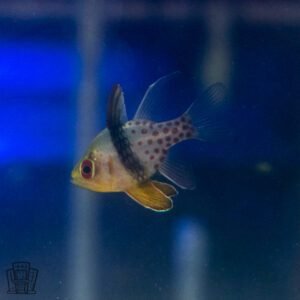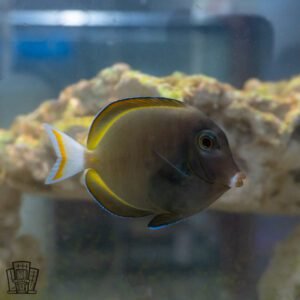Description
- Scientific Name: Ctenochaetus binotatus
- Common Names: Twospot Bristletooth Tang, Blue-eyed Tang, Twospot Surgeonfish
- Maximum Length: 8 inches (20 cm)
- Minimum Aquarium Size: 70 gallons (265 liters) for a single fish; larger for multiple to support their grazing and swimming needs.
- Foods and Feeding Habits: Herbivorous, feeding on algae and detritus in the wild. In aquariums, offer nori seaweed, spirulina-based flakes or pellets, and occasional mysis or brine shrimp. Feed 2-3 times daily, ensuring ample algae growth on live rock for natural foraging.
- Reef Safety: Reef-safe; they graze on algae without harming corals or most invertebrates, ideal for reef tanks.
- Temperament: Semi-aggressive, especially toward other tangs or similar species. Best kept singly or with dissimilar, peaceful tankmates like gobies or wrasses.
- Description: The Twospot Bristletooth Tang is a vibrant addition to marine tanks, valued for its algae-cleaning prowess. Its body is orange-brown with fine blue lines and spots, a blue ring around the eye, and two distinct black spots at the base of the dorsal and anal fins. Native to the Indo-Pacific, from East Africa to the Tuamotu Islands, they inhabit coral and rubble areas of deep lagoons and seaward reefs at depths of 8-60 meters. Their active grazing and hardy nature make them a favorite for aquarists seeking a functional yet colorful fish.
Fun Facts:
- Their comb-like teeth are uniquely adapted to scrape fine algae films from rocks, leaving distinctive grazing marks visible on reef surfaces in the wild.
- In the wild, they form loose schools to overwhelm territorial damselfish, gaining access to prime algae patches through sheer numbers.
- They can produce a faint clicking sound during feeding, caused by their teeth scraping against hard substrates, audible to divers in quiet reef waters




